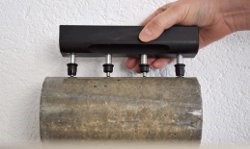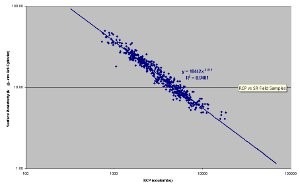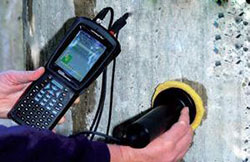All Things Corrosion
We have chosen to highlight corrosion investigation and initial condition assessment of structures.
Our first article talks about the expanded use of concrete resistivity for lifecycle estimation and how it is being used to replace the Rapid Chloride Penetration test and our second article introduces some of what our visiting expert from Force Technologies in Denmark Mr. Oscar Klinghoffer had to say about corrosion investigation and monitoring..
Concrete Resistivity as a QA Tool
The Rapid Chloride Permeability (RCP) test was originally introduced in the 1990’s as a means of assessing reinforcement corrosion protection provided by concrete. Originally it was thought to combine a measure of chloride diffusion and resistance to current flow and hence give a result that could be used to assess corrosion protection afforded through the initiation and propagation phases. In Australia chloride diffusion tests were already being used to assess concrete performance, but the tests took a long time and had by then been proven to only give information on the initiation phase. Also there were no simple criteria.
 Later there were criticisms of the RCP on the basis that it was primarily a measure of resistivity and that some additives could give results indicating poor corrosion resistance whereas the additive increased corrosion resistance, e.g. calcium nitrate. However the RCP has remained a popular quick QA tool for assessing concrete corrosion resistance. As a QA tool the RCP test criteria can be set for the specific concrete mix at the time of the mix trials.
Later there were criticisms of the RCP on the basis that it was primarily a measure of resistivity and that some additives could give results indicating poor corrosion resistance whereas the additive increased corrosion resistance, e.g. calcium nitrate. However the RCP has remained a popular quick QA tool for assessing concrete corrosion resistance. As a QA tool the RCP test criteria can be set for the specific concrete mix at the time of the mix trials.
It has been recognised that resistivity is related to chloride ingress in the initiation phase through the Nernst-Einstein equation and also directly related to the propagation phase as it controls the corrosion rate in many situations. Hence RILEM has published research on using resistivity to indicate design life in the paper “Electrical Resistivity as Microstructural Parameter for the Modelling of Service Life of Reinforced Concrete Structures”
 A study initiated in 2002 by the Florida Department of transport has determined a strong correlation between Rapid Chloride Penetration [RCP] measurements and saturated resistivity measurements taken on the same samples (see image Right). This discovery means testing can now be done in 10 minutes instead of 10 days using the same cylinders or cores used to determine compressive strength. To solidify this ASSHTO have drafted the Surface Resistivity Test specification to standardise the test.
A study initiated in 2002 by the Florida Department of transport has determined a strong correlation between Rapid Chloride Penetration [RCP] measurements and saturated resistivity measurements taken on the same samples (see image Right). This discovery means testing can now be done in 10 minutes instead of 10 days using the same cylinders or cores used to determine compressive strength. To solidify this ASSHTO have drafted the Surface Resistivity Test specification to standardise the test.
 Replacement or augmentation of the RCP test with Surface Resistivity tests of saturated samples has the added benefit of lower costs and greater volume of tests. It is easy to visualise the concrete lab removing the test cylinder from the water bath, placing the Resistivity meter on the cylinder and then placing it in the compression testing machine for crushing.
Replacement or augmentation of the RCP test with Surface Resistivity tests of saturated samples has the added benefit of lower costs and greater volume of tests. It is easy to visualise the concrete lab removing the test cylinder from the water bath, placing the Resistivity meter on the cylinder and then placing it in the compression testing machine for crushing.
PCTE are proud to represent Proceq and their concrete NDT products. Proceq have introduced the ResiPod for Resistivity measurements. It is a one piece device which is rugged and water proof. Proceq recognised a significant limitation of resistivity measurements was calibration and probe contact. The Resipod has been designed to overcome both issues, special probe design and current compensation makes it a market leading device.
Corrosion Monitoring and Investigation
 PCTE were excited by a visit from Oskar Klinghoffer of Force Technology to Australia in October. He presented a paper on Durability Design for the Concrete Institute of Australia’s conference. Force includes ‘Corrosion Centralen’, a Danish company famous in the 70’s and 80’s for its pioneering research and application of corrosion testing. Force continues to be a world leading consultant in this area but is also famous for the testing equipment they have developed such as the Galvapulse and its successor the Corromap, a range of embedded corrosion monitors <<CorroWatch, CorroRisk>>, and ERE 20 MnO2 reference electrodes. Oskar is the leader of their concrete department and is a sought after speaker on corrosion assessment and monitoring. PCTE were fortunate to get Oskar to come to Australia and after the Concrete 2011 conference he met with companies around Australia on a mini-Roadshow.
PCTE were excited by a visit from Oskar Klinghoffer of Force Technology to Australia in October. He presented a paper on Durability Design for the Concrete Institute of Australia’s conference. Force includes ‘Corrosion Centralen’, a Danish company famous in the 70’s and 80’s for its pioneering research and application of corrosion testing. Force continues to be a world leading consultant in this area but is also famous for the testing equipment they have developed such as the Galvapulse and its successor the Corromap, a range of embedded corrosion monitors <<CorroWatch, CorroRisk>>, and ERE 20 MnO2 reference electrodes. Oskar is the leader of their concrete department and is a sought after speaker on corrosion assessment and monitoring. PCTE were fortunate to get Oskar to come to Australia and after the Concrete 2011 conference he met with companies around Australia on a mini-Roadshow.
Oskar’s paper during this conference “Durability Design Using Risk Assessment and Monitoring” discussed life cycle models, a more comprehensive as-built process known as a birth certificate, and went into great detail about the opportunities and benefits presented by corrosion monitoring and investigation. For those who were not fortunate enough to see Oskar present at the conference we have included links to his paper and conference slides below. Some highlights were:
- Corrosion monitoring is increasingly being used on major European structures to reduce risk however assessment of results yields varying results and sufficient probes to ensure a representative view on corrosion are required
- The MnO2 embedded reference electrodes have been operating for over 30 years in some structures. The electrode has been proven to be more stable than silver/silver chloride reference cells and to give a longer services life (Long Term Performance of MnO2 Reference Electrodes in Concrete)
- Reliability is not included as part of current national codes but is becoming an important part of the design process (e.g. Fib model code 2010)
- The Corromap which is the successor to the highly popular Galvapulse is in prototype stage now for the incorporation of corrosion rate measurement. It is currently being tested and will be released in April 2012
Durability Design Using Rish Assessment - Conference Slides


